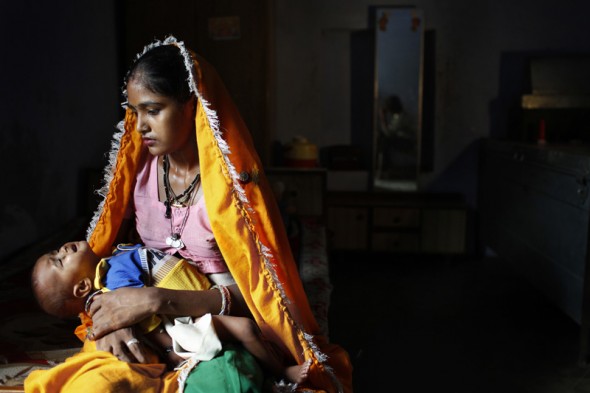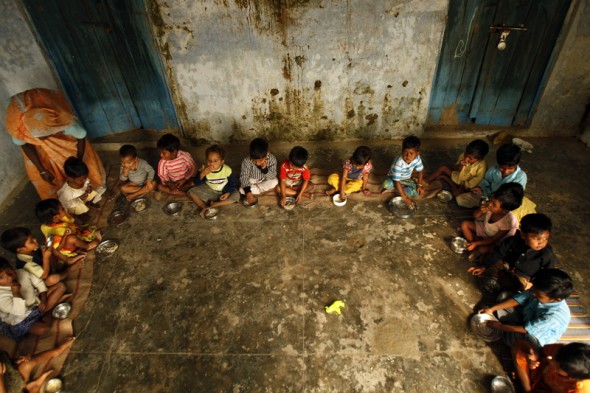-
Making ‘Beyond Seven Billion’: Reporting on Population, Environment, and Security
November 8, 2012 By Carolyn Lamere“When I embarked on this series, I approached it as an environmental reporter: What does a growing number of us and growing consumption mean for our planet?” said Los Angeles Times reporter Ken Weiss at the Wilson Center on October 9. Weiss, along with photographer Rick Loomis, recently completed a five-part series and multimedia presentation on global population that was the culmination of a year of research and travel through more than six countries. [Video Below]
Before he began the project, Weiss said, “I knew very little about this topic, and I was too young to have read The Population Bomb when it came out, and so like a lot of people I had this sort of general, vague notion of what this was all about, but it was sort of shrouded in this fog of uncertainty.”
Turning to sources at the United Nations Population Fund, U.S. Census Bureau, and the Population Reference Bureau, Weiss said he found “a clear consensus among top demographers in which direction we’re going.” Although, in aggregate, women around the world are having fewer children, the world’s population is still increasing due to population momentum. Because there are more young people now entering their reproductive years than ever before, even if they have fewer children than their parents, the result is still a larger number of births than before.
“We’re at a very critical juncture in history,” Weiss said. Depending on decisions made by young people today, especially in developing countries, the world population in 2100 could range as high as 15.8 billion people or as low as 6.2 billion, according to UN estimates.
Decisions and Choices in India, Kenya, and the Philippines
In India, Weiss spoke with Ramjee and Mamta, a young couple who married when they were 10 and 11 years old. After having two children by age 15, Ramjee decided to stop. He wanted to provide for the children he already had and to give them the opportunities he gave up for his early marriage. “He thought it was a mistake for him to start having children so early. He had to give up school, his dreams of going to university and getting a good-paying job,” said Weiss. Despite vehement opposition from his mother and grandmother, Ramjee and Mamta decided Mamta should be sterilized.
In Kenya, Weiss encountered an entirely different attitude. Mohamed Abdi Yussuf, a Somali youth leader in a refugee camp with chronic food shortages, told Weiss he wanted 70 children, saying, “I don’t worry what the children will feed on. They have their own fate. They have their own mouths, teeth. God knows what to put in there.”
Weiss met with Kenyan women who disagreed with their husbands’ wishes for large families, including some who snuck off to a clinic every three months to get a contraceptive injection.
“What I saw over and over again in our travels, is when these poorest, these least-educated women have options, and realize they have options to plan their families, that they seize them,” he said. “And sometimes they do so at the risk of angering their husbands, or even their mothers-in-law.”
Some families’ choices are limited by lack of access to contraceptive supplies.
In the Philippines, Weiss spoke to Yolanda and Noel Naz, who planned to have only three children but were stymied after the mayor of Manila ordered public clinics to stop distributing free contraceptives. A reproductive health bill would make family planning supplies more accessible but has been stalled in the country’s congress for 14 years. While the Catholic Church’s objection to birth control is at the root of the controversy in the Philippines, some Catholics, like Yolanda, want to use contraception despite papal disapproval. “When I go to Mass, I hear the priest give sermons saying that pills are bad. But whenever I hear that, I just say to myself that for me, it’s not evil, it’s not bad, or it’s not sinful. What is more sinful is to have more children than I can afford to feed,” she told Weiss.
Youth and Stability in Afghanistan
“We are literally going to see one billion young people come into the populations in the arc of instability over the next two decades,” Weiss said, quoting demographer Jack Goldstone, who works on the connections between youthful populations and instability. “We can’t fight them. We have to figure a better way to help them.”
In Afghanistan, where the median age is 16.6, Weiss interviewed imprisoned Taliban fighters about their motivation for joining the insurgency. He learned that the Taliban provided members with a dowry – a critical enabler for marriage and transition to adulthood.
“My life got better when I joined the Taliban,” said one young man. “If all Afghans had good jobs, if we had peace and stability, we would not go for the fight,” said another.
Weiss cited the work of Richard Cincotta and Elizabeth Leahy Madsen, who found that conflict is more likely and democracy less likely in rapidly growing countries with what Weiss called ”vast ranks of restless young men.” However, he emphasized that large numbers of youth are not sufficient to start a conflict; rather, they provide “kindling” for another “spark,” such as ethnic friction, political rivalry, or economic disparity.
Telling Untold Stories
“This is journalism of the highest order,” said discussant Tom Hundley of the Pulitzer Center on Crisis Reporting. “These are the kinds of stories that we believe need to be reported.”
The Pulitzer Center supports reporting on difficult and neglected stories, including women’s issues like child marriage, maternal health, and family planning. “We do these stories because increasingly traditional media outlets are unable to do them on their own,” said Hundley. Declining profits mean that newspapers can no longer finance the foreign bureaus that would cover these issues.
To illustrate Pulitzer’s approach, Hundley screened Too Young to Wed, a short documentary about child marriage created by Stephanie Sinclair with support from the Pulitzer Center and National Geographic.
“Child marriage occurs in more than 50 developing countries around the world, and almost always results in the girl’s removal from school. What families don’t realize is that by curtailing girls’ education, they’re only perpetuating the cycle of poverty,” said Sinclair in the film.
As Weiss mentioned, the inferior status of women can be a “driver” of population growth, just as women’s education can help empower women to make choices about their careers, goals, and family size. Marrying young means women are likely to have more children in their lifetime, while girls who stay in school tend to marry later and have fewer children.
Population Is About People
While discussions about population can get bogged down by numbers or mired in controversy, Weiss emphasized that at its heart, population is about people.
“The big surprise for me is realizing the key to this issue is really helping poor people – particularly women – realize their potential by giving them the power to make decisions over their lives, and their futures, and their families,” Weiss said.
“The stakes are high, and the suffering is really too great for us to ignore this.”
Event Resources:
For more on Ken Weiss’ Beyond 7 Billion, see New Security Beat’s coverage of the series and read the articles on the Los Angeles Times’ mini-site.
Sources: The Guardian, The Los Angeles Times, Pulitzer Center for Crisis Reporting, UN Population Fund.
Photo Credit: All photos by Rick Loomis. Copyright, 2012, Los Angeles Times. Used with permission.
Topics: Afghanistan, Africa, aging, Asia, demography, development, family planning, featured, From the Wilson Center, gender, India, Kenya, media, Philippines, population, security, video, youth
 A Publication of the Stimson Center.
A Publication of the Stimson Center.






